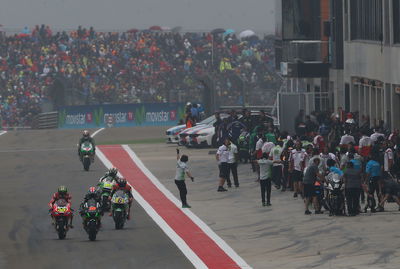MotoGP to remove artificial grass, reconsider flag-to-flag

Following a meeting of the MotoGP Safety Commission at Motegi, Dorna director Javier Alonso has revealed that the use of artificial grass on the edge of the race track will mostly be phased out and the flag-to-flag rules reconsidered.
Both issues were raised by riders after Aragon, where the slippery artificial grass caused a heavy accident for Valentino Rossi. When rain arrived, race leaders Marc Marquez and Dani Pedrosa then fell while attempting to stay out on slicks, rather than choosing to pit for wet weather bikes as allowed by 'flag-to-flag' rules.
Alonso told the official MotoGP website: "Even though we were the first ones, motorcycle racing, to request artificial grass, now we have realised that in that particular condition when the track is dry and the artificial grass is still wet, it is really, really dangerous. So we are going to gradually take it out from the circuits, starting from the most dangerous places of course."
The main purpose of the artificial grass is to stop riders deliberately exceeding the track limits. Removal of corner entry grass seems a no-brainer after Rossi's fall, since there is no performance gain from running wide under braking, but an alternative method to deter riders from going over the kerbs on corner exit may now be needed.
Regarding the flag-to-flag rules, introduced in 2005 to avoid the need to stop a race due to weather changes, Alonso admitted the regulations could now be tweaked to force all riders to change bikes. At present the bike change is voluntary and, the nearer to the end of the race that rain arrives, the greater the incentive to stay out on slicks - especially for those at the front.
"We have always said that [flag-to-flag] is the least worst option and that if we can improve it somehow and the riders feel there is some room for improvement we will try to do it," Alonso said.
"We are sure that the system of flag-to-flag, the system of changing bikes, is the best system we can have, but it may be that we consider having an option where if it gets too wet we oblige everybody to change the bikes. But we are not sure yet if this is correct or not, so we have to first study those options and see if there is something better than we have today."










